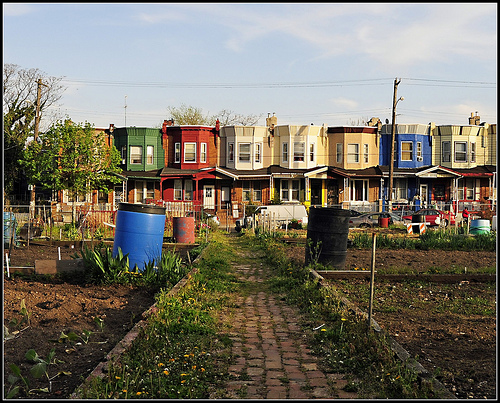 More green on the streets will mean less brown in the rivers.Tony the Misfit via flickrPhiladelphia has a poo problem. Old, failing pipes plus a swelling population plus lots of rain equals — well, yuck. So the city has pondered its options, and now it’s poised to make a major splash in the world of sewage management.
More green on the streets will mean less brown in the rivers.Tony the Misfit via flickrPhiladelphia has a poo problem. Old, failing pipes plus a swelling population plus lots of rain equals — well, yuck. So the city has pondered its options, and now it’s poised to make a major splash in the world of sewage management.
In a move described by an official from the state environmental council as “the most significant investment in transforming the city that we’ll see in our lifetimes,” Philly is proposing a $1.6 billion plan to radically alter the way it handles stormwater — not only the practicalities, but the philosophy behind them.
The new system, which must be approved by the EPA, would use green roofs, rain gardens and barrels, porous pavement, and other tools to “deal with rainwater where it lands” instead of building tunnels and plants to divert and treat it, said Howard Neukrug, founding director of the city’s Office of Watersheds. The primary goal: to keep aging sewage pipes from sending waste into the Schuylkill and Delaware rivers, smaller waterways, and occasionally even homes. But a nice side benefit? A greener, cleaner cityscape.
Voicing an idea so practical it hurts, yet ignored the whole world ’round, Neukrug said, “Instead of figuring out how to manage this pollution, maybe we should be looking at how to prevent it in the first place.”
 Howard Neukrug: Greening Philadelphia, one storm drain at a time.Neukrug has apparently been nipping at the heels of greener stormwater management for a decade, since three Department of Water programs merged in 1999 to create his Office of Watersheds, which serves two million residents. Over the years, he has gained attention for his progressive approach, testifying before Congress and starring in a wave of coverage on the city’s techniques three years ago. The City of Brotherly Love’s watery ways have even been hailed by the Sierra Club.
Howard Neukrug: Greening Philadelphia, one storm drain at a time.Neukrug has apparently been nipping at the heels of greener stormwater management for a decade, since three Department of Water programs merged in 1999 to create his Office of Watersheds, which serves two million residents. Over the years, he has gained attention for his progressive approach, testifying before Congress and starring in a wave of coverage on the city’s techniques three years ago. The City of Brotherly Love’s watery ways have even been hailed by the Sierra Club.
So it’s clear that the recently unveiled plan did not spring full-grown from Rocky’s head. In fact, it’s reportedly been in the works for twelve years. Still, now that the 3,369-page plan exists and has landed with a thud on EPA’s desk, the press and observers are all atwitter, and several neighborhoods are eager to get greened up. “This is the most significant use of green infrastructure I’ve seen in the country, the largest scale I’ve seen,” EPA regional water-protection direct Jon Capacasa told the Philadelphia Inquirer, while NRDC water-expert Nancy Stoner called the potential scaling-up of these proven techniques “really exciting.”
Ken Kirk, who heads the National Association of Clean Water Agencies, praised the plan to the Inquirer as well: “[At] the end of the day, they will be using a lot less energy, they will be using the water resources more efficiently, they will be capturing and recharging groundwater under the city, they’ll have less pollution of the rivers … That is the way we need to go.”


